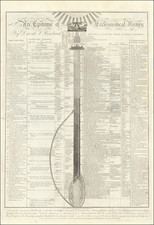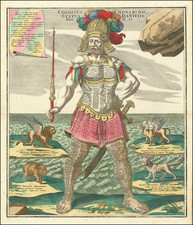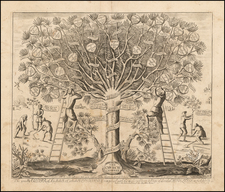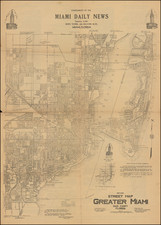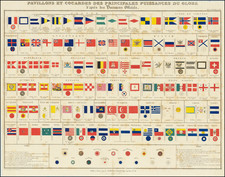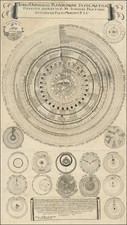"I look on myself as a Patron and Protector as well as master to my negroes..."
Prominent East Florida Loyalist and Colonial Doctor's Instructions on Medical Treatment of Enslaved People.
Laudanum and Mercury: Extensive Medical Advice From the "First Native South Carolina Physician to Practice in the Colony"
A fascinating handwritten document by John Moultrie, Lt. Governor of East Florida and a prominent plantation owner who had come to Florida from South Carolina.
Likely written from St. Augustine, the capital of East Florida, these handwritten instructions are dated May 16, 1784, shortly before Moultrie sailed for London in July of the same year following the British cession of Florida to Spain. The document is captioned by Moultrie: “Thoughts that may be of use to my people and plantation in the Bahamas and orders that I beg may be obeyed.”
The text, evidently written when Moultrie was preparing to return to Great Britain after serving as a deputy governor of East Florida, is largely given to advice on how to treat illnesses, but the conclusion of the “Thoughts” is devoted to Moultrie’s instructions on the treatment of enslaved persons, naming specific people such as "Old Frank" and Quamino, and including the unintentionally ironic admonition, “I would have them made as happy as their condition will admit.”
This is an important summary document on the British experience in Colonial East Florida, a period that lasted just over twenty years, from 1763 to 1784. The memorandum reveals the outlook and preoccupations of this important colonial physician, planter, and slave owner as he contemplated the loss of his fortune following Britain's defeat in the Revolution. Moultrie was intimately involved in the British project to turn Florida into a slave plantation aristocracy like the rest of the Southeast.
Dr. John Moultrie, Jr. as a physician
Moultrie was born to the famous South Carolina family of that name in Charleston in 1729. John was the older brother of General William Moultrie, who defended Charleston from the British during the Revolution. John was the only one of the four living Moultrie brothers to side with the Loyalists during the Revolution. Moultrie's father, Dr. John Moultrie (Sr.), was educated as a doctor at the University of Edinburgh. Moultrie Jr. followed in his father's footsteps and traveled to Scotland to receive his medical education in 1746.
The South Carolina Encyclopedia says of his medical training:
...he received his M.D. in 1749. He was the first native-born American to graduate in medicine from Edinburgh, which was then emerging as the leading medical school in the western world.
Moultrie’s Latin dissertation on yellow fever, De Febre Maligna Biliosa Americae (On the American Malignant Bilious Fever), is notable as one of the earliest clinical descriptions of the disease to come from North America. The work was based on careful observations of the Charleston epidemic of 1745, made while he was assisting his father as an apprentice, and his own experience with a mild attack of the disease. The underlying causes of yellow fever, he claimed, were excessive heat, miasma (putrid air) from the swamps and poorly drained areas, and heavy consumption of spiritous liquors. He noted that the epidemic subsided as the weather cooled; that it was especially common among the poor, those who worked in the sun, sailors, heavy drinkers, and strangers; and that it was rare among those from the West Indies, the wealthy, young children, the temperate, African Americans, and Native Americans. Moultrie’s dissertation was not a major contribution to medical knowledge, but its precise clinical descriptions attracted a great deal of attention. It was translated into German and French and published in numerous editions into the nineteenth century.
Moultrie was evidently the first native-born South Carolinian to receive formal medical training and practice in the colony. It is important to consider that although the medical advice contained in this document is positively medieval by modern standards, it was coming from perhaps the most experienced doctor in the American Southeast at the time.
Moultrie as a plantation owner
The South Carolina Encyclopedia relates the progress of Moultrie's political and military career:
Moultrie’s political life began when the governor appointed him a justice of the peace in 1756. During the French and Indian War, he joined the militia and rose to the rank of major. In 1761 he served under Lieutenant Colonel James Grant, a British regular, during an expedition against the Cherokees. In the same year he was elected to the colonial assembly. In 1764 Grant, now governor of East Florida (newly acquired from Spain), appointed Moultrie to his council. Moultrie moved to Florida and soon became the council president. In 1771 Grant named him lieutenant governor. Moultrie prospered as a planter in Florida and amassed a large amount of land and numerous slaves.
After receiving Florida from Spain in 1763, the British hoped to transform the colony into a slavery-based agricultural powerhouse like the rest of the Southeast. Moultrie had experience in this line; his father was a prominent indigo planter in South Carolina who owned hundreds of enslaved people. Likewise, John Jr.'s brother, William, is said to have owned at least 200 enslaved people.
John Moultrie brought 180 enslaved people from South Carolina to Florida, establishing himself as one of the first and most successful planters in East Florida. He owned two plantations in northeast Florida: Bella Vista on the Matanzas River, some four miles from St. Augustine, where Moultrie had a stone mansion and pleasure gardens, and Rozetta Plantation, located on the Tomoka River, comprising 2000 acres. Raab, Spain Britain, and the American Revolution in Florida, 1763-1783, page 24 describes this history:
Overall plans for the development of the colony hinged on persuading established planters from South Carolina and Georgia to relocate to East Florida. Grant's new lieutenant governor, John Moultrie, was such an individual. He was the eldest son of Dr. John Moultrie of Charleston and a brother of William Moultrie. He had graduated from Edinburgh, had come home in 1753, and became a prominent and wealthy doctor, plantation owner, and citizen. Moultrie took up almost 20,000 acres in land grants. Becoming one of the first proprietors and planters, "being honored with the appointment of lieutenant governor, he broke up and dismantled his plantations in South Carolina, and moved all his Negro families into Florida." Moultrie's 180 slaves already knew how to clear virgin lands and plant rice, indigo, and provisions crops of corn, beans, and potatoes. John Moultrie would establish two plantations.
Following Britain's defeat in the American Revolution, Florida was handed back to Spain. This resulted in many Loyalists attempting to relocate to nearby British territories.
According to one source, Moultrie brought 150 enslaved people to the Bahamas in 1784 to establish new plantations.
In 1784 John Moultrie, a South Carolinian, was Lt. Governor of East Florida. A Loyalist, he sent some 150 slaves to The Bahamas to start new plantations... many of whom had previously worked his rice plantations along the Santee River (boundary between Charleston County and Georgetown County) soon established new plantations on New Providence and other islands in The Bahamas. These slaves pioneered the cultivation of long-staple cotton so important in the antebellum history of Beaufort District and other parts of South Carolina and Georgia - Beaufort District Collection Connections, "Searching the Bahamas for Gov. Moultrie's Forgotten People."
The loss of his Florida plantations was a ruinous blow to Moultrie. Raab says of it:
After finally achieving a life of real plenty, ease and elegance, in a province that had recently shown an astonishing productivity in agriculture, lumber, and naval stores, Moultrie was about to be turned adrift... Moultrie was disturbed about the fate of his Negroes, especially a number of faitful servants brought up for several generations in his family... In July 1784, he sailed to England, leaving behind three brothers, Thomas, Alexander, and William, all patriot soldiers.
After spending seventeen years in East Florida, Moultrie retired to London, apparently dependent on an annuity of £500. He made claims to the East Florida Claims Office for losses of £9,432, being awarded only £4,479.
Transcription
Here follows a complete transcript of the text:
Thoughts that may be of use to my people and plantation in the Bahamas and orders that I beg may be obey'd. May 16, 1784 John Moultrie
Sickness
In all inflamatory fevers, pained coughs colds there is no medicine so safe and at the same time so very effective as Vinegar. I know of nothing preferable to it to procure sweating - give 5 or 6 spoon full in 1/2 a pint of warm water per dose which may be given 3 or 4 times a day if necessary in violent fever pluerisies coughs & it must not be given by any means in agues and disorders where people are very much relaxed or blood desolved. I desire that a quantity of Vinegar may be always kept where any of my people are it is easily made -- by sweetening 10 or 12 gallons of whater and adding about a gallon of rum.
For vomits keep always some Tartar Emetic it is a good general general vomit Put about 6 or 8 grains in a quart of water and give a gill or more at a time until the patient has vomited sufficently it may be given to people of all ages - to a suckling child you may give about a spoon full of it the quart of water in which 8 grains of Tartar has been disolv'd and repeat it untill sufficient vomiting has been procured. Tartar emetic given this way in small doses is a safe medicine to open the belly and promote perspiration.
For purges keep some Jallop, purging salts and some sweet mercury - 40 grains of jallop for a dose for a grown person - and handhull of salts in a pint of water is about a dose for a man - and a dose of mercury for a quick purge 20 grains. 20 grams of jallop 10 of mercury becomes a good purge where a smart one is wanted. Keep always ready a lancit and a slyster syringe and Spanish flus for blisters.
Opium a grain is a dose for a grown person and liquid laudunum which answers the same ends 25 drops a dose must always be kept, it may be of service in cholicks, gripes, purges and vomiting but remember in general to promote vomiting or purging before you give the opiate.
In bloody fluxes or [..dys?] or violent pain full looseness give purging salts repeat the dose as often as is necessary in the morning and give the opiate at night. This will do in simple case not long standing - in very inveterate old fluxes five grains of Hippo maybe given every morning and the anadyne at night - if this does not do you may try 5 grains of mercury and one grain of tartar mix'd into a pill & given for several mornings still giving the anadyne at night. Brandy and water the best drink in longstanding fluxes tha patient weak. In violent bleeding of the nose and from other parts as from the womb &c small doses of purging salts given several times a day just to move the belly is a safe and most effectual remedy and if the bleeding should bring the patient very low and other methods should fail - delay not to put a blister to the back - if anything will stop the bleeding this will if the Patient is weak and low - but it must not be appy'd to a strong sanguine person in the first state of the disorder. In all bruised wound apply vinegar the first day to the bruise & dress the wound constantly with dry lint & cleanse it with salt water - in general all green wounds require no other dressing. [Salvers?] may be sometimes usefull in old foul ulcers to make the [?] and clean them but seldom fresh wounds.
The following alternative powders is usefull as an alternative - in foulness disorders & ulcers of the skin at the same time let the patient wash with salt walter - it may be given to help the cure of foul old ulcers.
Take tartar emetic 5 grains - sweet mercury 20 grains a lump of sugar mix them well and divide them into 10 equal doses - give one every day to a grown person - half the quantity to a boy or girl.
Five grains of whole vitriol in 4 spoonfulls of water is a good eye water in sore eyes; but if there is great inflamation & violent pains purging must be used first & [stoups?] & washing with warm vinegar.
In sore throughts muffle the head and neck well keep warm take a dose of purging salts drink warm vinegar and water often this will keep up a constant sweat which ought to be done as the easiest and most sure & safe way off removing the disorder.
In venerial disorder give the alternative powders after a dose of salts and then use an injection of a spoonfull of honey and 3 spoonfulls of water 1/2 a spoonfull brandy and 20 grains of mercury.
In teeth aches a pill of opium gives relief put into the hollow tooth.
I look on myself as a Patron and Protector as well as master to my negroes - many of them have been very faithful and were out - I wou'd have them made as happy as their condition will admit they continuing faithfull deligent industrious and well behav'd attentive to my business.
Old Frank has never done amiss that I know of let him be made happy and live where he will & let him have any better article he may want and now and then a little grog to drink our healths.
Quamino has never behaved amiss, always well has never had a blow and beg he never may, he I think will never deserve it - I desire to make him independent of the Overseers he must be alow'd to go about among my people giving them good advice and seeing that they do not do amiss he is an old planter and may be of service in directing the negroes but he must not be struck by any manager or overseer - he is [?] and so is old Frank and may keep the keys of any stores, &c.
If it is found prudent & convenient without giving too much trouble any of the house negroes and old ones that behaves themselves well sober and quietly may be allow'd to work out themselves they paying regularly their wages but I do ...
Please note that in the 1966 catalog entry for this letter, it is described as being "6 pages, folio (last 2 pages very defective)". We conclude that the last two pages were unfortunately lost or discarded due to being very defective.
Provenance
Lieutenant Colonel G.H. Hay, D.S.O., Duns Castle, Berwickshire, Scotland;
Sale of the above, Christie's, 1966 (part of group lot 101, RBH reports the selling price for the whole as $1,064);
Willcocks;
[...]
Jay Kislak;
His sale, Sotheby's, April 26, 2022.











